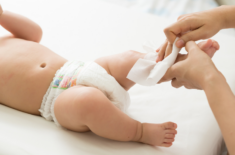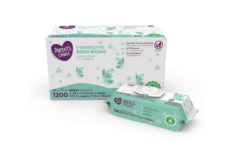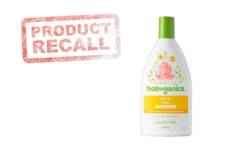Overview
In 2021, batches of Huggies baby wipes were recalled in Australia due to contamination with Burkholderia cepacia bacteria. (1)
However, this isn’t the first time Huggies products drew concern over safety issues.
In 2015, some moms posted about finding shiny particles in their Huggies baby wipes on social media. They believe that these might be glass particles. (2)
Baby wipe products come in contact with your baby’s sensitive skin. So, it’s very important to ensure that they’re gentle, soft, and free from harsh chemicals, harmful bacteria, and other dangers, such as the shiny particles reported by these moms.
Did Huggies recall the baby wipes over the possible safety concerns in 2015? What Huggies products have been recalled, why were they recalled, and what should you do if you bought these affected products? Do Huggies wipes cause diaper rash?
Continue reading to find out.
What Huggies Products Have Been Recalled?
Huggies makes a wide range of diapers and baby wipes. Although the baby wipes had been recalled in Australia in 2021 for safety concerns, no other Huggies products have been recalled.
Were Huggies Wipes Recalled In 2021?
Yes. On December 24, 2021, Kimberly-Clark Australia and the ACCC (Australian Competition and Consumer Commission) announced the urgent recall of two lots of Huggies Thick Baby Wipes Fragrance-Free – Limited Edition Tropical due to bacterial contamination. It only affected two batches. (1)
Here are the details of the recall involving these Huggies products:
- Affected batch codes: B21072004 and D21072005
- Designs: The Little Mermaid design and Toy Story’s Rex dinosaur design
- Sizes: 3 x 80s and single 80s packs
- Production date: July 21, 2021
- Selling dates: From October 1, 2021, and onwards
These recalled products were sold exclusively through Woolworths stores in Australia.
The urgent recall was initially announced for the Little Mermaid design. Still, Kimberly-Clark Australia later announced the inclusion of Toy Story’s Rex dinosaur design, which was also sold under the brand’s Limited Edition, tropical packaging.
You can also check the packaging for the following information about the products involved in the recall:
- Single 80s wipe pack SKU (stock keeping unit) 11120, with barcode 9310088014846
- Value pack containing three single packs of 80 wipes SKU 24355 with barcode 9310088014877
Why Were The Huggies Wipes Recalled?
According to the recall advisory posted by Kimberly-Clark Australia, these baby wipes were recalled due to bacterial contamination with Burkholderia cepacia. (1)
Tests showed the presence of the bacteria only in these two batches (batch code B21072004 and D21072005), both made on July 21, 2021.
Kimberly-Clark Australia explained that Burkholderia cepacia doesn’t usually pose a medical risk to healthy people. However, it can cause serious bacterial infections and health complications for those with weakened immune systems. (1)
The company assured consumers that they could confirm the safety issue only affected the two batches, with no other Huggies baby wipes or products affected.
What Should Affected Consumers Do?
All consumers who bought baby wipes with the Little Mermaid design and Toy Story’s Rex dinosaur designs were instructed to check the packaging to see if their item had the following batch codes: (1)
- B21072004
- D21072005
These batch codes were printed on the side of the pack, next to the production date code of 21.07.2021.
After confirming that their Huggies products were included in the recall, affected customers should stop using them immediately.
Kimberly-Clark Australia announced that customers could choose whether to get a product replacement, refund, or gift card in exchange for the recalled product. (1)
Affected consumers didn’t have to return the recalled baby wipes to the store where they bought them from. Instead, they were asked to destroy or dispose of the recalled items.
However, they were reminded to take a photo of the affected product, particularly with its batch code visible in the picture, before disposing of the items. They should also provide photos that they have already destroyed or disposed of the recalled products before they can process their claim.
Consumers were told to submit the affected product’s photos through the online contact form on their website (kimberly-clark.com.au). They can also call the Huggies team from 8 AM to 4 PM AEST at 1800 028 334 from Monday to Friday.
Those who hadn’t destroyed the product yet were told to notify Kimberly-Clark Australia so that safe product disposal could be monitored.
Huggies Baby Wipes Glass Shard Issue In 2015
Back in 2015, several moms took to social media to express their concerns over possible “shards of glass” that they found in their newly purchased Huggies baby wipes.
A mom from Camarillo, CA, Melissa Estrella, posted a Facebook video in August 2015 after allegedly finding these glass shards in her daughter’s Huggies baby wipes. (2)
This Facebook video went viral, gaining more than 6.4 million views. However, Estrella reportedly took the video down after striking a deal with a viral video licensing firm, Jukin Media, which now owns the rights to the clip. (2)
According to reports, this particular video shows Estrella opening three packages of newly bought Huggies baby wipes. She could be seen brushing off what looked like glass shards with her fingers. (2)
Estrella claimed that it hurt as if something had stabbed her when she used the product to wipe her face. (2)
Another mom, Kelsea Andrews from Knoxville, Tennessee, also had a similar experience. (3)
Andrews was surprised to see the glistening, abrasive particles from the second batch of Huggies baby wipes she bought. She explained that the new batch was different from the previous one she bought, so she was able to compare and see the difference.
However, Andrews was puzzled why Huggies wouldn’t issue a recall because they asked her to send back the products for testing to find out what was in the wipes. She wonders why Huggies still announced that their products were safe but were also unsure about what might be in these items. (3)
She doesn’t believe that the baby wipes have glass, saying that the glistening particles might be polypropylene plastic, one of the product’s ingredients. However, Andrews hoped that Huggies would investigate the matter and recall the possibly unsafe baby wipes.
Did Huggies Issue A Recall Over The Glass Shard Issue?
No. Huggies, in response to these allegations, released a media statement that they don’t use any glass material to manufacture their baby wipes. (2)
Kimberly-Clark, the manufacturer of Huggies, didn’t issue a product recall over the glass shard issue despite many parents urging the company to recall the item over the possible safety concern.
The brand claims that the shiny particles that the moms thought were glass shards are actually the shimmer caused by microfibers reflecting light in the baby wipes.
Although they didn’t issue a recall, Kimberly-Clark was able to retrieve some samples from a number of customers who reportedly found what they thought were glass shards in Huggies baby wipes. The company sent these samples to a third-party independent laboratory, McCrone Associates, Inc., for testing.
Kimberly-Clark later announced that the third-party testing only found microfibers in the baby wipes, no glass.
The brand also assures worried parents that all Huggies products are thoroughly tested and evaluated to ensure their safety. Aside from putting stringent quality control measures in place, the brand repeatedly assured everyone that they don’t use glass to make their baby wipes.
Worried consumers were told to contact Huggies through their hotline at 1-888-485-6839 or online contact form if they had further questions.
Kmart Guam Pulls Out Stocks Of Huggies Baby Wipes
Despite not receiving any official announcement from Kimberly-Clark, the Kmart store chain in Guam (US territory) decided to pull Huggies baby wipes off their shelves as a safety precaution amid this 2015 issue. (4)
The local Kmart’s HR coordinator, Daisy Lee, announced that customers are welcome to return Huggies baby wipes they bought from the store for a full refund if they find glass shards in them.
Consumers praised the store for its “reactiveness” in keeping their customers safe.
A representative from the Guam Department of Public Health and Social Services, Claire Baradi, also praised the store for the proactive action even if they were still waiting for Kimberly-Clark’s announcement.
After Kmart pulled out these Huggies baby wipes, a resident of Barrigada, Guam, reportedly complained to the store about it. Amparo Cruz said that after hearing about Kmart pulling the baby wipes off their shelves, she immediately checked the items she bought from the store. (4)
She said that, like the packs in Estrella’s viral video, there were also glass shards in the Huggies packs she bought from Kmart. (4)
Cruz said that she was disappointed and sad at the same time, especially because her daughter was treated for a bacterial infection on her buttocks. Although she couldn’t also say if that was due to the wipes, Cruz said that her daughter had been complaining during diaper changes.
She believed that the wipes could have been the source of her daughter’s bum infection. (4)
FAQs
Are Huggies Wipes Safe To Use?
Kimberly-Clark maintains that Huggies baby wipes are safe to use.
Do Huggies Wipes Have Fiberglass In Them?
According to Kimberly-Clark, Huggies wipes don’t contain fiberglass.
Do Huggies Wipes Cause Diaper Rash?
Some parents complained that Huggies baby wipes might have caused diaper rash in their babies. However, there are also others who used the product but didn’t report the same experience.
Doctors suggest choosing baby wipes that are free from harsh ingredients like parabens and irritating preservatives to reduce the risk of skin irritation and diaper rash.
Food & Product Safety For Babies
Wipes & Diaper Safety
Babies have sensitive skin, so choosing gentle and safe products is important.
In buying products that touch their skin, such as baby wipes and disposable diapers, you can check for any recall notices, safety issues, or relevant information on the brands’ official websites (e.g., Pampers or Huggies diapers) to see whether these are free from harsh, toxic chemicals that can cause diaper rash.
Some tips from the CDC (Centers for Disease Control and Prevention) for the proper use of diapers and baby wipes: (5)
- Only use fresh, clean baby wipes or diapers. Don’t recycle them.
- Wipe your baby’s bottom starting from front to back.
- Keep all dirty diapers, baby wipes, and soiled clothes from any surface that can be difficult to clean.
- For disposal, put the used baby wipes inside the dirty diaper.
- Dispose of these used diapers and baby wipes into a diaper pail. You can also use a plastic-lined lidded trash bin.
- You can apply diaper cream if needed.
- Put a new diaper on and fasten lightly. Check that it isn’t too tight because that can also lead to diaper rash.
- It’s also ideal to wash your child’s hands with soap and water after each diaper change.
Baby Food & Formula Safety
It’s very important to regularly monitor baby food or formula recalls, especially those involving bacterial contamination (e.g., Salmonella or Cronobacter), which can cause serious infections and even be deadly to babies. (6)
For example, last February 2022, two babies died due to bacterial infections linked to Similac products. Their deaths sparked a massive Similac recall that worsened the formula shortage in the US.
Safety With Baby Wipes
Ingredients To Avoid
Baby wipes with these ingredients can be harmful to your baby:
- Phthalates – these aren’t usually listed but can be found in scented products; they can disrupt the endocrine system and multiple organ functions (7)
- Parabens – these preservatives can mimic estrogen in your baby’s body, influence abnormal breast cell growths, and increase cancer risks (8)
- Polysorbate 20 – it can contain a chemical linked to liver cancer, the 1,4 dioxane (9)
- PEG (polyethylene glycol) – might also contain 1,4 dioxane (10)
- Phenoxyethanol – it can also contain 1,4 dioxane content (10)
- Benzyl alcohol – it’s an irritant that can cause moderate skin inflammation (11)
- Propylene glycol – this petroleum-based chemical can irritate your baby’s skin (12)
- Sodium benzoate – studies show that it could affect the cerebellum (a part of the brain) and worsen or cause ADHD (attention deficit hyperactivity disorder) (13)(14)
- Fragrances – there’s a debate on whether or not fragrances could cause cancer and other serious health risks to people, but it might be best to avoid products with fragrances to be on the safe side (15)(16)
- Triclosan – it’s a preservative with antimicrobial properties but can also cause irritation and immunosuppression (17)
- Cocamidopropyl betaine – this can be an irritant (18)
What Baby Wipes Are Toxic?
These brands or products can contain some of the harmful ingredients listed above:
- Pampers Baby Wipes Complete Clean Baby Fresh Scent – contains PEG-40 hydrogenated castor oil, sodium benzoate, and fragrance
- Huggies Natural Care Sensitive Baby Wipes – contains Polysorbate 20
- Johnson’s Hand and Face Wipes – contains sodium benzoate and fragrance
- Kirkland Signature Baby Wipes – contains sodium benzoate
- Eco by Naty Aloe Vera Baby Wipes – contains sodium benzoate
- Burt’s Bees Baby Wipes – contains sodium benzoate and benzyl alcohol
Note that baby wipes need some preservatives to prevent mold and bacterial growth because they must stay moist. However, it’s good to check their label to avoid baby products with the possibly harmful preservatives mentioned above.
Healthier Baby Wipes
Some brands that have the least chemical ingredients and are free from sodium benzoate or the other ingredients listed above:
- WaterWipes Biodegradable Original Baby Wipes
- Earth’s Best TenderCare Unscented Chlorine-Free Baby Wipes
- Parasol Co Clear+Pure Baby Wipes
- Jackson Reece Kinder by Nature Unscented Baby Wipes
- Bloom Baby Banana Milk Sensitive Skin Baby Wipes
How To Check If Your Baby Product Is Recalled
It’s important to regularly check for any recalls on products you use for your baby.
- Baby formula recalls
- Baby food recalls
- Baby clothes recall
- Baby bath soap recall
- Inclined sleeper recalls
- Baby lounger recall
- Baby bottle recall
- Pacifier recall
- Diaper recall
Aside from these links, you can also check the following to see if your baby products have been recalled:
Official Federal Websites
- recalls.gov
- cpsc.gov of the CPSC (Consumer Product Safety Commission) – for various children’s or household products
- fda.gov of the FDA (US Food and Drug Administration) – for medicines, food, baby formula, and other relevant product recalls
- nhtsa.gov of the NHTSA (National Highway Traffic Safety Administration) – for car seats and vehicle recalls
Brand & Retailer Websites
You can also check the brand’s official website for recall notices or safety announcements. For example, you can go to gerber.com for Gerber product recalls or visit pfizer.com for Pfizer product recalls.
Some popular brands or online shops, including Similac (similacrecall.com), have a dedicated site or separate link for recall announcements.
Recall sections of online retailers like Amazon, Sam’s Club, Target, buybuy BABY, and Walmart can also contain relevant recalls and safety information.
Apps & Social Media
The CPSC (Consumer Product Safety Commission) released the CPSC Recall App for consumers to stay updated with any recalls and product safety concerns.
The recall app also allows users to search for product recalls from the CPSC’s database.
Social media platforms, apps, and sites like Tiktok, Twitter, and Facebook might also help alert you to possible recalls, but be sure to check the websites mentioned above to avoid misinformation.
REFERENCES
(1) https://www.huggies.com.au/limited-edition-baby-wipes-recall
(2) https://ktla.com/news/local-news/huggies-responds-to-reports-of-glass-shards-on-baby-wipes/
(3) https://www.wbir.com/story/news/2015/08/24/knoxville-mother-huggies-baby-wipes/32288743/
(4) https://www.guampdn.com/news/local/kmart-pulls-wipes/article_70042d60-edb0-52b9-9174-2d059b4c4608.html
(5) https://www.cdc.gov/healthywater/hygiene/diapering/in-the-home.html
(6) https://www.cdc.gov/cronobacter/infection-and-infants.html
(7) https://www.ncbi.nlm.nih.gov/pmc/articles/PMC8157593/
(8) https://www.bcpp.org/resource/parabens/
(9) https://wwwn.cdc.gov/TSP/ToxFAQs/ToxFAQsDetails.aspx?faqid=954&toxid=199#
(10) https://www.fda.gov/cosmetics/potential-contaminants-cosmetics/14-dioxane-cosmetics-manufacturing-byproduct
(11) https://datasheets.scbt.com/sc-326216.pdf
(12) https://wwwn.cdc.gov/TSP/ToxFAQs/ToxFAQsDetails.aspx?faqid=1121&toxid=240
(13) https://www.ncbi.nlm.nih.gov/pmc/articles/PMC4362157/
(14) https://www.ncbi.nlm.nih.gov/pmc/articles/PMC2137120/
(15) https://www.cancer.org/healthy/cancer-causes/chemicals/cosmetics.html
(16) https://www.ewg.org/news-insights/news/expert-panel-confirms-fragrance-ingredient-can-cause-cancer
(17) https://www.ncbi.nlm.nih.gov/pmc/articles/PMC6126357/
(18) https://www.mcgill.ca/oss/article/health-you-asked/does-ingredient-cocamidopropyl-betaine-found-some-personal-care-products-cause-dermatitis










